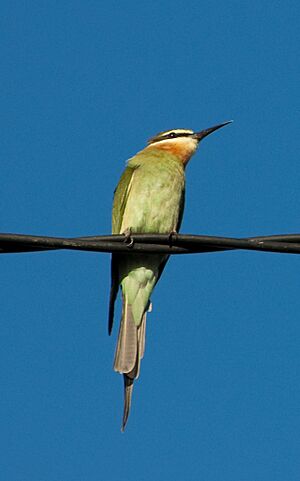Olive bee-eater facts for kids
Quick facts for kids Olive bee-eater |
|
|---|---|
 |
|
| Conservation status | |
| Scientific classification | |
| Genus: |
Merops
|
| Species: |
superciliosus
|
The olive bee-eater (also called the Madagascar bee-eater) is a colorful bird known for eating insects, especially bees. Its scientific name is Merops superciliosus. These birds live in the southern parts of Africa, including countries like Angola, Madagascar, and Kenya. They are quite common and can be found in many places. Because there are so many of them, experts say they are a "least concern" species, meaning they are not currently in danger of disappearing.
Contents
About the Olive Bee-Eater
What's in a Name?
The olive bee-eater got its scientific name, Merops superciliosus, from a famous scientist named Carl Linnaeus in 1766. The word superciliosus comes from Latin and means "eye-browed." This probably refers to the white stripe above its eyes, which looks a bit like an eyebrow!
There are two main types, or subspecies, of the olive bee-eater:
- M. s. superciliosus: This type lives in East Africa, Madagascar, and the Comoro Islands.
- M. s. alternans: This type is found in western Angola and northwestern Namibia.
How to Spot One
Olive bee-eaters are medium-sized birds. They usually grow to be about 23 to 26 centimeters (9 to 10 inches) long. Their tail feathers can add another 7 centimeters (about 3 inches)!
Both male and female olive bee-eaters look very similar. They have pretty bronze-green feathers on most of their body. Their head is olive-colored, and they have bright white feathers on their forehead, above their eyes (like eyebrows), on their chin, and on their cheeks. Their lower back and tail are blue, but the long, thin tail feathers are black.
Where They Live
You can find the olive bee-eater in grasslands and coastal mountain forests. They are common in East Africa and Madagascar. There's also a group of them living by the coast in Angola.
As mentioned, the two subspecies live in different areas:
- The M. s. superciliosus type lives in eastern Ethiopia, Somalia, and Kenya. It also spreads south through East Africa to southern Mozambique and the Zambezi Valley. You can also find them on the Comoro Islands and Madagascar.
- The M. s. alternans type lives in western Angola and northwestern Namibia.
Life Cycle and Habits
Migration and Breeding
Olive bee-eaters are partly migratory. This means they don't stay in the same place all year. They usually fly north during the dry season in southern Africa. They mostly breed in the southern parts of their range.
When it's time to have babies, they dig a burrow (a tunnel in the ground) to make a nest. They usually lay four eggs at the start of the wet season in southern Africa. The baby birds, called chicks, typically hatch around the beginning of December.
Raising Their Young
Unlike some other bee-eater species, olive bee-eaters do not usually practice "cooperative breeding." This means that only the parent birds take care of their chicks, rather than other adult birds helping out.
After the chicks learn to fly (this is called fledging), they stay with their parents for about 19 days. This is a shorter time compared to many other bee-eater species. It's more like how birds in cooler climates raise their young.
Images for kids





